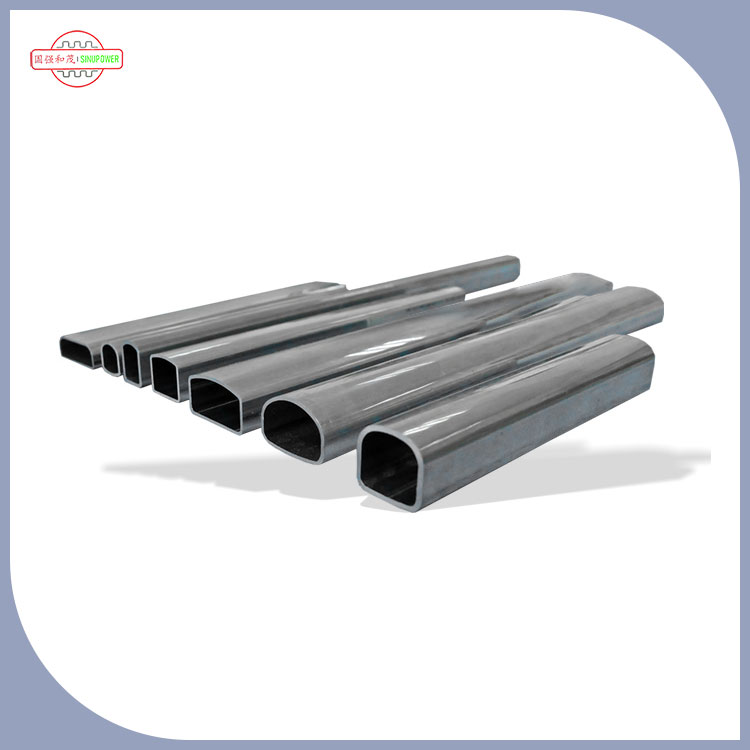D-type pipe is a type of pipe with a special cross-sectional shape, which is widely used in multiple fields. Its application characteristics are mainly reflected in the following aspects:
1. In terms of structure and mechanical properties
Unique bending resistance: The D-type cross-sectional shape of the D-shaped tube gives it good bending resistance in certain directions. Compared with circular pipes, D-pipes can more effectively resist deformation when subjected to lateral bending moments, which makes them advantageous in some structures that require specific directional bending forces, such as providing more stable support in supporting components of building structures or frames of mechanical structures.
Good spatial adaptability: The shape of the D-shaped tube can better adapt to some special spatial layouts. Its flat side can be tightly attached to the surface of other objects or installed in confined spaces, while the circular part can provide some space to accommodate or pass through other components. For example, in some pipeline systems that need to be tightly attached to walls or arranged in narrow passages, D-type pipes can be installed and arranged more flexibly.
Uniform stress distribution: The structure of the D-shaped tube ensures a relatively uniform stress distribution when subjected to stress. When subjected to internal pressure or external loads, the special shape of D-shaped pipes can distribute stress throughout the entire pipe wall, reducing the phenomenon of local stress concentration, thereby improving the overall strength and reliability of the pipe, and reducing the risk of rupture or damage caused by stress concentration.

2. In terms of fluid transmission
Optimized fluid flow: When used for fluid transport, the shape of the D-tube can have a special impact on fluid flow. Compared with circular pipes, the fluid flow pattern inside D-shaped pipes may be different. The flat part can form a more uniform velocity distribution of the fluid to a certain extent, reduce the generation of eddies and turbulence, thereby reducing energy loss during fluid transmission and improving transmission efficiency. For example, in some industrial fluid transport pipelines or air ducts of HVAC systems, D-pipes can be optimized and designed according to specific flow requirements to achieve better fluid transport effects.
Strong self-cleaning ability: The shape of the D-tube helps to achieve a certain self-cleaning function during fluid transmission. When transporting fluids containing impurities or particles, the special cross-sectional shape of D-type pipes can enable the fluid to have a more effective flushing effect on the pipe wall during the flow process, reducing the deposition and adhesion of impurities and particles on the pipe wall, reducing the risk of pipeline blockage, and improving the stability and service life of the pipeline system.
3. Installation and connection aspects
Easy to install and operate: The flat part of the D-tube provides convenience for installation. During the installation process, it is more convenient to use fixtures, brackets, and other fixing devices to fix the D-shaped tube in the desired position. Compared to circular tubes, its flat surface can provide more stable support and positioning, reducing sliding and rotation during the installation process, and improving installation efficiency and correctness.
Diversified connection methods: D-type pipes can adopt various connection methods, such as welding, flange connection, clamp connection, etc. Due to the characteristic shape of D-type pipes, suitable connection methods can be selected according to specific application scenarios and requirements, and can be well adapted to other shapes of pipes or equipment, enhancing the overall flexibility and scalability of the pipeline system.
4. Appearance and aesthetics
Unique appearance effect: D-type pipes have a unique appearance shape, which can provide different visual effects from traditional circular pipes in some application scenarios that require appearance. For example, in fields such as architectural decoration and furniture manufacturing, D-pipes can be used as decorative structural components or decorative lines to add unique design and modernity to products or architectural spaces.
Strong customizability: The size, wall thickness, material, etc. of D-pipes can be customized according to specific design requirements. At the same time, various surface treatments such as spraying, electroplating, polishing, etc. can be carried out on the surface of D-pipes to meet different appearance colors, textures, and anti-corrosion requirements, so that they can better integrate into various design styles and environments.